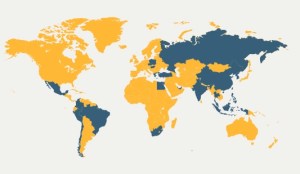The US dollar’s strengthening last year to a 20-year high had major implications for the global economy. We examine these spillovers from the currency’s appreciation in our latest External Sector Report.
Building on recent research by Maurice Obstfeld and Haonan Zhou, we find that negative spillovers from US dollar appreciations fall disproportionately on emerging market economies when compared with smaller advanced economies.
In emerging market economies, a 10 percent US dollar appreciation, linked to global financial market forces, decreases economic output by 1.9 percent after one year, and this drag lingers for two and a half years. In contrast, the negative effects in advanced economies are considerably smaller in size, peaking at 0.6 percent after one quarter and are largely gone in a year.
In emerging market economies, the effects of the strong dollar spread via trade and financial channels. Their real trade volumes decline more sharply, with imports dropping twice as much as exports. Emerging market economies also tend to suffer disproportionately across other key metrics: worsening credit availability, diminished capital inflows, tighter monetary policy on impact, and bigger stock-market declines.

External sector implications
In addition, US dollar appreciations impact the current account, which captures the change in saving-investment balances of countries.
As a share of gross domestic product, current account balances (saving minus investment) increase in both emerging market economies and smaller advanced economies, because of a depressed investment rate (there is no clear systematic response for saving). However, the effect is larger and more persistent for emerging market economies.
Exchange rate depreciation and accommodative monetary policy facilitate the external sector adjustment for advanced economies. In emerging market economies, fear of letting the exchange rate fluctuate and lack of monetary policy accommodation magnify the increase in the current account.

There, the income compression channel—where lower income leads to a decline in the purchase of imported items—plays a relatively bigger role. The external sector adjustment in emerging market economies is further hindered by their heightened exposure to the US dollar through trade invoicing and liability denomination.
Policies
Emerging market economies with more anchored inflation expectations or more flexible exchange rate regimes fare better.
More anchored inflation expectations help by allowing more freedom in the response of monetary policy. After a depreciation, a country can run a looser monetary policy if expectations are anchored. The result is a shallower initial decline in real output. In turn, emerging market economies with more flexible exchange rate regimes tend to enjoy a faster economic recovery owing to a sizable immediate exchange rate depreciation.

Flexible exchange rate regimes can be supported and facilitated by domestic financial market development that helps lessen the sensitivity of domestic borrowing conditions to the exchange rate. Sustained longer-term commitments to improving fiscal and monetary frameworks help anchor inflation expectations. This includes ensuring a well-balanced mix of fiscal and monetary policies, enhancing central bank independence, and continuing to strengthen the effectiveness of communications.
Global effects
Global current account balances are calculated as the sum of absolute current account balances across countries. It is a key metric in the IMF’s External Sector Report as it can indicate increasing financial vulnerabilities and rising trade tensions.
Our research shows that a 10 percent appreciation is associated with a decline in global current account balances by 0.4 percent of world GDP after one year. The magnitude of the decline is economically significant, as average global balances over the last two decades were about 3.5 percent of world GDP, with a standard deviation of 0.7 percent.
The decline in global balances reflects a broad-based contraction in trade in the presence of dominant currency pricing, facilitated by narrowing commodity trade balances, given falling commodity prices that have historically accompanied appreciations of the US dollar.
The study highlights the importance of going beyond standard country-level characteristics and macroeconomic policies. Precautionary policy tools, such as global safety nets, are important in addressing global financial market cycles and their spillovers.
In emerging market economies with severe financial frictions and balance sheet vulnerabilities, macroprudential and capital flow management measures could help mitigate negative cross-border spillovers.
IMF Blog




